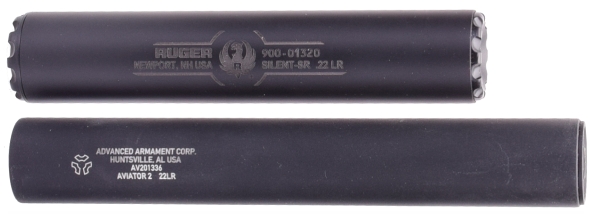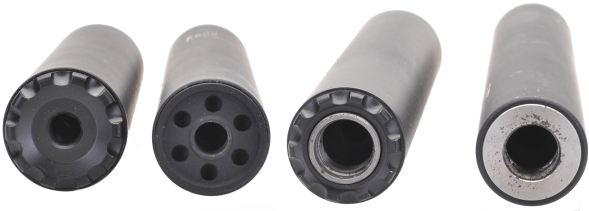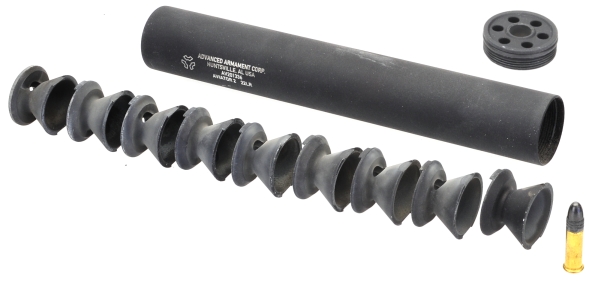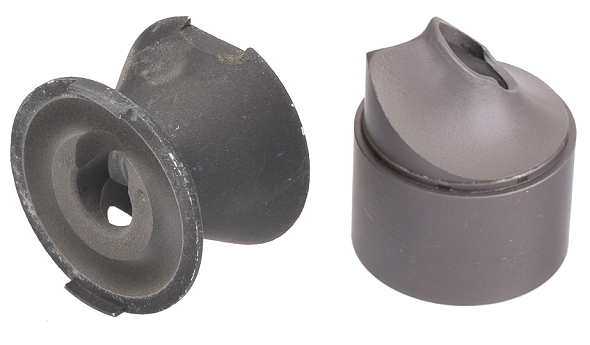
The idea was to shoot the Ruger American Rimfire with the Ruger Silent-SR, but it seemed better to drag in another product for reference. So not a comparative piece, just a “point out the differences” piece. Above, Ruger’s Silent-SR on top and Advanced Armament’s Aviator 2 beneath.
All sorts of stuff in there….
Both the Ruger and AAC come with a cap wrench. The six blind holes in the AAC end cap are there solely to accept the end cap wrench. They are not through holes and serve no suppressor function.

The Ruger, #1 and #3, utilizes aluminum end caps and a stainless steel muzzle mount. The AAC unit, #2 and #4 has an aluminum front cap and a non-removable stainless rear cap/muzzle mount. Both are as strong a mount, however, the Silent-SR is easier to service, which is an important issue as rimfire suppressors run dirty and need frequent cleaning.
Below, the Aviator 2 is different in construction than the Ruger Silent-SR. There are nine K type baffles (K being the shape of the cross section of the baffle), the first blast baffle is made of nitride coated stainless steel, the remaining eight are aluminum alloy. The proper orientation of the baffles is fixed by keying one to the other with 180º alternating position of baffle’s output ports. The tube volume is 60mL, but 20mL are displaced by the baffles and end caps, leaving a net volume of 40mL.

The blind holes, not through holes, in the front cap are for the spanner tool used for removal. No, I did not find the 22 LR round rolling around in there, it was placed for size context. These silencers are actually quite compact… jacket pocket small.
The Ruger Silent-SR, as noted in Part 1, is shorter in length and larger in diameter. However, the empty tube volume is also 60mL and the (L-R Below) muzzle mount, blast baffle and five primary baffles and end caps occupy 17.5mL for a net assembled volume of 42.5mL. All Ruger Silent-SR baffles are stainless steel.

Pictured above with the baffle stack broken down, and the large front cap tool that is included with the silencer. Where the AAC silencer’s K baffles are keyed to align gas ports and baffle direction, they are not sealed as a set and route gas into and onto the outer tube to cool and slow. The Ruger cone type baffles insert into one another and seal so that gas flow is tightly controlled within the baffles and never sees the outer tube. Baffles are not radially indexed, one to the other.
Below, the AAC Aviator 2 K baffle left and Ruger Silent-SR. Each takes a quite different approach to slowing and cooling combusted gases to reduce sound pressure levels. The AAC baffle passes a high pressure stream into an expansion chamber, which causes the gases to rapidly expand, which reduced gas velocity, temperature, molecular kinetic energy and, subsequently, sound levels.

The Ruger Silent-SR baffle has an enhanced pressure side form where the gas hits a deflecting and directing surface rather than the nearly flat faced baffle of the AAC Aviator 2. The gas in the Silent-SR goes on a swirling, brief road trip before passing through a non-symmetrical venturi and into an expansion chamber. The effect is a more active baffling scheme that leads to more rapid slowing and cooling of gases and further reduced sound levels.
I am sure there is a middle school student who will be giving me a physics reprimand, but I offer these empirical findings; A B-52D uses hot 16th stage jet engine bleed air, pushed into an expansion chamber for cooling as the aircraft’s method of air conditioning. Additionally, living in cold climates we use the same principles intuitively; mouth open wide and low pressure exhale to warm our hands, but purse our lips and push high velocity air out of our mouth to produce a cooling stream. Try it… just don’t pass out and blame me.
Couple of comments…
Checking silencer volume as an indication of cartridge capacity doesn’t take much in the way of tools; a couple of glass graduated cylinders, 100 ML and 250 ML and water. The silencer baffles are removed, front and rear caps are installed, a finger…. selection is optional, seals the rear cap opening, and the silencer is filled with water. The contents are then poured out into the graduated cylinder and the volume is read on the cylinder’s scale. This is the gross capacity of the tube.
Applying a little Archimedes, a graduated cylinder is filled with water to perhaps the 70mL mark for a 100ML cylinder and the baffles are carefully lowered into the cylinder, the amount the water level rises in mLs in the amount of volume the baffles will take from the gross tube capacity.
Once taken apart, a silencer that has been used should not be reassembled without cleaning. The powder residue is hard on aluminum and Titanium pieces and forcing baffles over grit will chew them up. A soak in ZEP Citrus cleaner, followed with a going over with a soft toothbrush cleans parts thoroughly and won’t harm any materials found in these silencers.
Ruger suggests that stacked baffles be separated by hand, but I could only pop them apart with a small hardwood dowel tapped through the center hole. When it came time to reassemble, the slip fit over joining shoulders would not cooperative and taping them on with a soft face mallet on the cone side could only lead to a curious snake like formation. Assembling the stack flat face down, to whatever extent was possible, then installing the muzzle mount and very lightly tapping of its flat face with a soft mallet, the column straighten up and all shoulders seated squarely.
How did the Ruger Silent-SR and AAC Aviator 2 perform?
All silencers are not created equally and designs evolve. In the case of the Ruger and AAC units, the Ruger is sound pressure reduction rated at 40 dB and the AAC unit at 41dB, however, the Ruger is perceptibly, significantly quieter. The seemingly contradictory result may very well be an inconsistency in how sound reduction was tested; distance from microphone, frequencies recorded, environment, range…
Normally we discharge suppressed firearms out in the wide open spaces, however, inclement weather put us in a sheltered, mostly enclosed shooting area using an LED lit chronograph. The enclosure tended to amplify sound, which probably helped to make the difference between the two silencers more noticeable.
| Ammunition | Bullet Grains |
Rated MV |
No silencer MV – FPS |
Ruger Silent-SR |
50 Yard 3 Shot Group “ |
AAC Aviator 2 |
50 Yard 3 Shot Group “ |
| Remington Subsonic | 38 | 1050 | 983 | 949 | 0.6 | 919 | 0.9 |
| Eley Target | 40 | 1085 | 1035 | 1052 | 0.4 | 1042 | 0.8 |
| Remington Golden | 40 | 1255 | 1182 | 1215 | 0.5 | 1174 | 0.7 |
| Winchester TIN | 26 | 1650 | 1533 | 1552 | 1.0 | 1507 | 1.2 |
| Winchester Super Speed | 40 | 1300 | 1252 | 1237 | 0.6 | 1193 | 0.9 |
The standard length for a rimfire test barrel is 24″, which explains the difference between the ammunition’s ratings and the 22″ barrel Ruger without a silencer in place. Silencers installed, the Ruger Silent-SR yielded consistently higher velocity than the Advanced Armament Corp unit and produced more accurate results. The Ruger American Rimfire proved to be reliable, accurate and with silencer, adaptable.
No, the level of silence even with the quieter Ruger Silence-SR in place was not “piff” silent. With subsonic loads the sound was more akin to that of a subsonic air rifle. The Remington Golden ammunition had the sound of a supersonic air rifle with a distinctive but mild whip cracking sound. The Winchester TIN round was very close in report to unsuppressed subsonic velocity ammunition, however, the sound seemed to be projected well forward of the shooter… me. No report was loud enough to scatter small game for acres and none were loud enough to cause discomfort while shooting without ear protection.
I do not know where Ruger is going with their silencer line, but this seems a good place in the market to begin. States seem to be moving in a direction of liberalizing the use of silencers, Congress is at least actively hearing the issue of removing this equipment from Class III status and, with increased production and supply, price cuts usually follow. The Ruger Silent-SR may be just the beginning of another good thing.
As a foot note – The proper nomenclature for this piece of equipment is “Silencer” as defined by theinventor’s patent, current manufacturers and the ATF, which is not the same as what it does; suppress sound pressure levels. I know this is very frustrating for engineering students and pseudo technical gun forum messiahs who feel the need to remind us that silencers do not make firearms absolutely silent. Yeah, we know. Now stop trying to rewrite history.
The Ruger Silent-SR’d American Rimfire Part I
The Ruger Silent-SR’d American Rimfire Part II

Email Notification